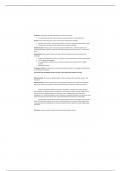Economics- study of how humans make decisions in the face of scarcity,
Can be individual decisions, family decisions, business decisions, or societal decisions
Scarcity- human wants for goods, services, and resources exceed what’s available
Ultimate scarce is time… everyone has 24 hours in a day to try and acquire the goods they want
At any point in time there is only a finite amount of resources available
Division of Labor- the way a good or service is produced is divided into a number of tasks that are
performed by different workers, instead of all the tasks being done by the same person… idea by Adam
Smith
Specialization- allows workers to focus on the parts of the production process where they have an
advantage
People have different skills, talents, and interests, so they will be better at some jobs than others
Can be affected by geography
If you specialize in a certain task, you will learn to produce more quickly and with a higher
quantity
Specialization allows…
Economies of Scale- for many goods, as the level of production increases, the average cost of producing
each individual unit declines
The division and specialization of labor has been a force against the problem of scarcity
Microeconomics- the actions of individual agents within the economy, like households, workers, and
businesses
Macroeconomics- focuses on broad issues such as growth of production, the number of unemployed
people, the inflationary increases in prices, government deficits, and levels of exports and imports
Based on the Stanford reading, economics is everywhere. Throughout the reading, Stanford
shows examples of what economics is and where it is. For example, he says to just take a walk and you
will see economics. Stanford believes that economics is very straightforward and that everyone
participates in it. I think that Stanford is correct. Economics is everywhere whether if you have a job, how
much you’re paid, or even where you live. I agree with Stanford that economics is fairly simple.
Some features of neoclassical economics are that it focused more on the people rather than the
classes. Neoclassical economics also focused on market equilibrium at any point in time instead of the
evolvement over time. Additionally, the theorists answered economic questions through mathematical
techniques.
Economics- study of economic activity carried out by human beings in society
,Economic Activity- any activity that seeks to provide a person with the means to live life
- action that involves producing, distributing, or consuming products or
services
Examples: working, shopping, running a business, making something to sell, childcare,
the governments activities, cooking, volunteering, travelling, NOT LEISURE ACTIVITIES
Where can it occur?
- Workplaces, businesses, markets, at home, by the government, in the
community
Neoclassical economics- takes markets as a starting point even though there may be other locations for
economic activity
- Value of a commodity (price) depends on supply and demand: how much
someone wants it and is willing to pay for it, compared to how much is
available
- But sometimes markets don’t work how they’re supposed to leading to
market failure
Microeconomics- the actions of individual agents within the economy, like households, workers, and
businesses
Macroeconomics- focuses on broad issues such as growth of production, the number of unemployed
people, the inflationary increases in prices, government deficits, and levels of exports and imports
Chapter 2
Budget constraint- outer boundary of an opportunity set, indicates all the combinations
Opportunity set- identifies all the opportunities for spending within the budget
Marginal analysis- comparing the benefits and costs of choosing a little more or a little less of a good
Utility- satisfaction a good or service provide
Law of diminishing marginal utility- as a person receives more of a good, the additional (or marginal)
utility from each additional unit of the good declines
Sunk costs- costs that were incurred in the past and cannot be recovered, should not affect the current
decision
In neoclassical economics, demand and supply determine outcomes in the market
The fundamental Neoclassical Problem
What determines demand and supply?
, o How consumers and producers choose to maximize their returns given scarce resources
with competing uses
o The problem… choice and decision making
Choice
Sometimes a scarcity of resources so there are costs to making certain choices
Economics is about how economic agents might use our resources and make choices which will make
life better for ourselves
Defining Opportunity Cost
Opportunity Cost- the highest valued next best alternative that is sacrificed to satisfy a want
Ceteris paribus- keeping things constant
True cost: direct cost + opportunity cost
Discussion Post:
Some examples of economic decisions I make in my daily life are if I should go to work, if I should
buy more clothes, and should I go out to eat instead of eating at home.
Recently, I made the decision to live on campus even though most of my classes are online. This was
an economic decision because I had to make a choice of whether I should sacrifice a college
experience or if I should risk getting sick while being on campus. I decided to live on campus because
I wanted to meet people and build connections.
When making an economic decision, I consider if the benefits outweigh the risks on my everyday life.
If the decision involves other people as well, I will take into consideration their views, so I am able to
make the best decision for everyone.
This is true because scarcity will always exist. Scarcity is necessary to organize economics on because
we are all experiencing the ultimate scarce which is time. When making an economic decision you
must thing about how much time is required for that choice. All resources that we value are scarce
whether its labor, land, money, tools, or other goods and services.
Section 2.2
Production Possibilities Frontier (PPF)- the problem of choice can be depicted for an economy
through this model
o All the points show the various combinations that an economy can produce




